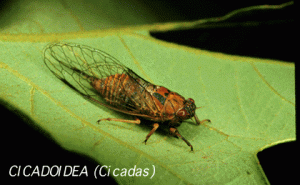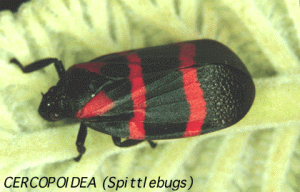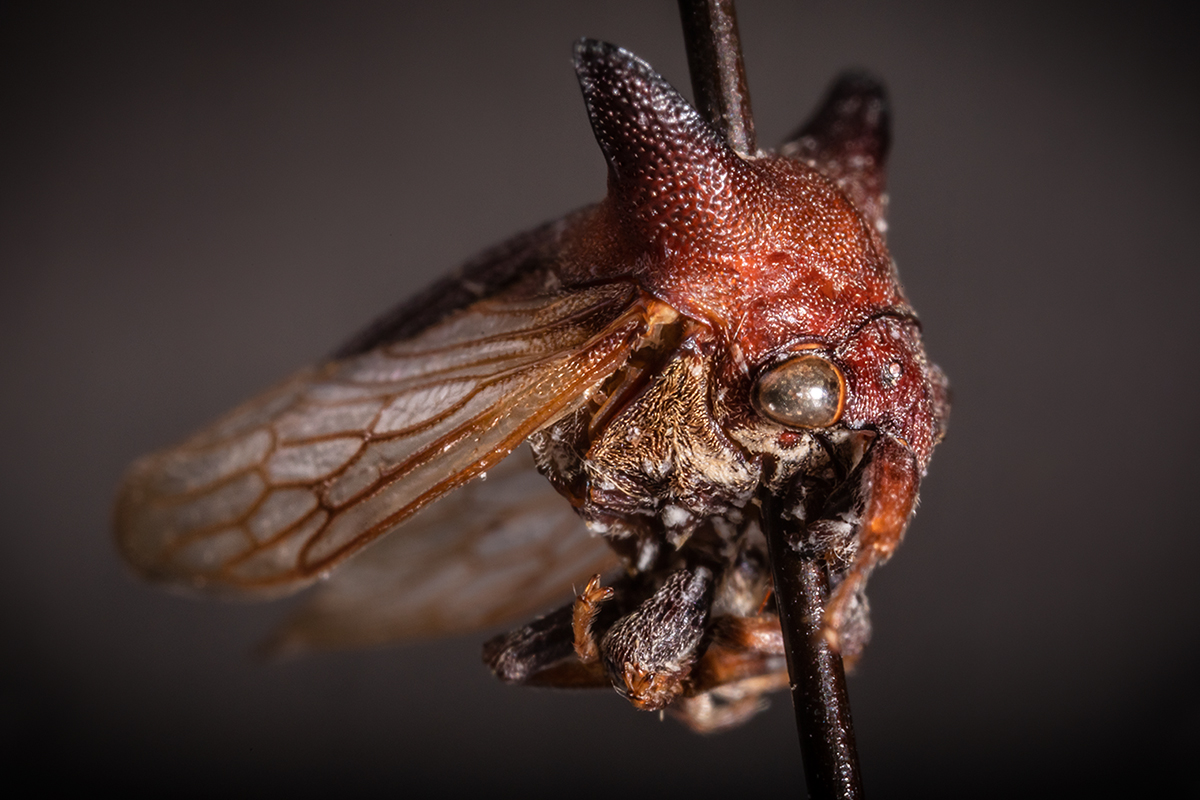This page provides general information on leafhopper ecology, biodiversity, and natural history. Follow the links to get more detailed information, pictures, etc.
What are leafhoppers?
Leafhoppers are insects belonging to the family Cicadellidae in the order Hemiptera. They are recognized by their piercing-sucking mouthparts and by the presence of rows of spine-like setae (hairs) in their hind tibiae.
Why are leafhoppers in the order Hemiptera? All my books have them in Homoptera.
Recent paleontological and DNA evidence indicates that Homoptera gave rise to Heteroptera (the true bugs = Hemiptera sensu stricto in many textbooks). Thus, Homoptera appear to be paraphyletic with respect to Heteroptera. Because most taxonomists now avoid formally recognizing paraphyletic groups in classifications, many entomologists have begun treating Homoptera+Heteroptera as a single order Hemiptera (sensu lato) instead of recognizing two distinct orders. The Tree of Life website shows the most recent estimate of the phylogeny of Hemiptera.
Where do leafhoppers occur?
Leafhoppers can be found on all continents in nearly every habitat that supports vascular plant life, including deserts, grasslands, wetlands and forests. They are usually found feeding on the above-ground stems or leaves of plants.
How many species of leafhoppers are there?
No one knows for sure. Approximately 23,000 species have been described (making Cicadellidae one of the 10 largest families of insects), but many new species are being discovered each year. Based on preliminary samples from Amazonian rainforest canopies, the true number of leafhopper species may exceed 100,000! New leafhopper species are being discovered almost every day—see a list of the most recently discovered species.
Why are there so many species of leafhoppers?
We’re still working on that one! The great diversity of the group probably stems from a combination of factors including their long (ca. 125 million year) evolutionary history, their association with an enormous variety of flowering plants, and their success at occupying a broad range of habitats and climates.
How are leafhopper species identified?
Although many species are easily recognized by their distinctive shapes and color patterns, many leafhopper groups contain numerous species that closely resemble one another and are difficult to distinguish. In some genera, the most reliable morphological features for distinguishing species are the male genitalia, which usually can only be examined after the abdomen has been cleared (see below). Published insect field guides include, at most, only a few of the most distinctive and colorful leafhopper species. Published keys are available for many leafhopper genera, but these are often based only on the male genitalia and are difficult to use. A few web-based keys are available. At present, the only reliable way to identify many species is to compare them to authoritatively identified specimens in an institutional collection. When in doubt, consult the experts!
What are their relatives?


Leafhoppers belong to the superfamily Membracoidea, which includes three families of treehoppers: families Membracidae, Aetalionidae, and Melizoderidae. More distantly related are other members of the infraorder Cicadomorpha: cicadas (Cicadoidea) and spittlebugs (froghoppers, Cercopoidea). Other, still more distant, relatives include planthoppers, aphids, whiteflies, psyllids, scale insects, and true bugs.
How big are leafhoppers?
Leafhoppers range in size from 2 to 30 mm in length.
How old are they?
Leafhopper individuals usually live for only a few months. However, they are members of a very ancient lineage that has changed little since the time of the dinosaurs. The oldest true leafhopper (Cicadellidae) fossils are known from the lower Cretaceous period (125 million years ago). Modern leafhopper genera are known from the Eocene and leafhoppers from Baltic and Dominican amber (35-55 million years old) are virtually indistinguishable from species that exist in those areas today.
What is their life cycle?
Details of the life cycle vary from species to species. In general, the female inserts several eggs into the living tissue of the host plant. The eggs either remain dormant for a period ranging from a month to over a year, or develop and hatch within a few weeks. The young, known as nymphs, feed on plant sap by inserting their beaks into the vascular or parenchyma tissues of the host plant and go through a series of five moults (shedding their exoskeleton), reaching the adult stage after a period of several weeks or months. Adult males and females seek each other out for mating, locating each other through specialized courtship calls.
What do leafhoppers eat?
All leafhoppers feed on plant sap. Leafhopper species feed on a wide variety of vascular plant species, including grasses, sedges, broad-leafed woody and herbaceous plants of many families, and conifers. At least one leafhopper species can usually be found feeding on the each of the dominant plant species in practically every terrestrial ecosystem. Frequently several leafhopper species can be found coexisting on the same plant.
What eats leafhoppers?
Because they are one of the most common and abundant groups of herbivorous insects, leafhoppers are an important food source for vertebrate predators such as birds and lizards, as well as invertebrate predators such as spiders, assassin bugs, wasps, and robber flies. Leafhoppers are also attacked by various parasitic insects such as dryinid and mymarid wasps, epipyropid moths, pipunculid flies, and strepsipterans. Because they feed on plant sap, leafhoppers are not usually susceptible to infection by viral, bacterial, or protozoan pathogens. Thus, entomopathogenic fungi, which do not need to be ingested in order to infect insects, are the most important leafhopper pathogens.
How do leafhoppers communicate with each other?
The same way their close relatives, the cicadas, do. They use special sound producing organs at the base of their abdomens called “tymbals” to produce songs. Most leafhopper songs are too faint to be heard by human ears without special amplifying equipment.
Are leafhoppers harmful to plants?
Sometimes. Leafhoppers injure plants either directly, through feeding which can damage plant tissue and rob the plant of essential nutrients, or indirectly, through the transmission of plant pathogens such as viruses, mycoplasma-like organisms, or other microorganisms. These include Pierce’s Disease.
Are leafhoppers harmful to humans?
Several species of leafhopper are serious agricultural pests. These include the potato leafhopper, beet leafhopper, white apple leafhopper, two-spotted leafhopper, and the glassy winged sharp shooter.
There have been a few anecdotal reports of leafhoppers biting humans, but these incidents appear to be accidental and rare. Interestingly, a researcher in Denmark (Lundsgaard, T. 1997. Virus Research 48: 35-40) recently found Filovirus-like particles in the salivary glands of a common European grass-feeding leafhopper, Psammotettix alienus (Dahlbom). The four previously described viruses of the genus Filovirus cause incurable diseases in humans, including a particularly gruesome one known as Ebola hemorraghic fever.
Are there endangered species of leafhoppers?
The geographic distributions and abundances of most leafhopper species are so poorly documented that their conservation status is unknown. Nevertheless, some species associated with threatened habitats, such as North American tallgrass prairie, are officially listed as threatened or endangered by several U.S. states.
What are the best methods for collecting leafhoppers?
Leafhoppers are most commonly collected by sweeping vegetation with a heavy muslin sweep net. Many species are also attracted to lights. Perhaps the most effective method is vacuum collecting. A gasoline- powered leaf blower fitted with a vacuum attachment (available at most lawn and garden shops) can be used to suck leafhoppers from dense vegetation. A fine-mesh insect net bag should be taped to the end of the intake nozzle to capture the leafhoppers (and lots of other interesting insects!). Another effective collecting method is insecticidal fogging of forest canopy. Entomologists at the Smithsonian Institution have collected hundreds of undescribed leafhopper species by fogging the canopy of a few sites in the Amazonian rainforest of Brazil, Peru, and Ecuador. Leafhoppers can be killed in a standard insect killing jar containing cyanide or ethyl acetate and mounted on pins or points, or preserved in 70-95% ethanol.
How are leafhopper specimens prepared for study?
Leafhoppers are usually mounted dry on pins or point mounts. Pins should be used for only the largest specimens and should be inserted through the mesothorax just to the right of center. Point mounts should be glued to the right side of the thorax. A label that includes the locality and date of collection, the name of the collector, and the host plant, if known, should be pinned beneath the specimen. To identify the specimen to species it is often necessary to examine the male genitalia. To do this, the abdomen is removed and soaked in 10% potassium hydroxide solution for several hours (or boiled in the same solution for a few minutes) to clear the pigment. The abdomen is then rinsed in clean water containing a small amount of glacial acetic acid, rinsed again in pure water, and immersed in glycerine. After examination, the cleared abdomen is stored in a glass or plastic microvial pinned beneath the rest of the specimen. Leafhoppers may also be preserved indefinitely in 80-95% ethanol. This method facilitates later extraction of nucleic acids (DNA and RNA) for use in phylogenetic and population studies.

